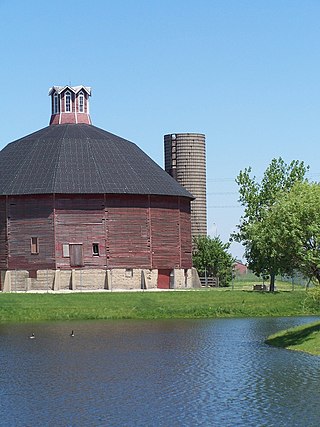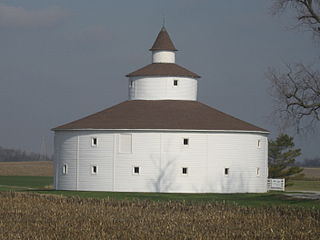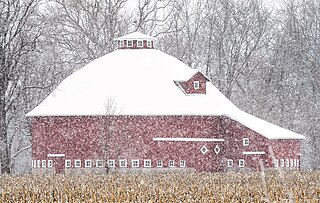History
Construction
When Charles E. Lewis decided he needed a large barn for his large herd of cattle and hogs, he thought outside the box, so to speak. Having heard about three round barns built around 1900 for the College of Agriculture at the University of Illinois, he was intrigued. The efficiency of the round barn's structure is what impressed Lewis, but he didn't need the university's barns - he needed a much larger barn. His mind began to build a vision of a barn that was much larger than any round barn built in the Midwest, at the time. He selected 40 acres (16 ha) of timbered land from the 160-acre (65 ha) Grove Place, a recent acquisition of his father's estate. The land was thick with large elm and oak trees, as well as other native Illinois tree species. Lewis built a portable sawmill at the site and hired several men to log the land with cross-cut saws and axes, while also working the logs into lumber and piling them to air dry. This occurred during the fall and continued well into the winter of 1911. [2]
Lambert Huber, a prominent carpenter in the area, was hired as architect, engineer and building foreman. Though he had never built a round barn, he decided to undertake the project. Even with Huber hired, construction on the barn could not commence until 1914, when all the lumber had sufficiently cured. [2]
The project itself was somewhat complicated, even for a round barn. The roof of the barn was to be an entirely self-supporting dome without structural support, to save the outside walls of the building. The four-section rafters of the roof would be reinforced at each of the joints. The project began with the digging of ditches where concrete foundation footings were poured. The footings would support the outer, circular wall. A 24-foot (7.3 m) diameter circle was laid out in order to accommodate the silo and silage feeding bunk around the silo. [2]
A 40-foot (12 m) stave silo was constructed at the site, with an 18-foot (5.5 m) diameter. The silo was constructed out of Douglas fir staves that had been totally cleared of knots. The barn itself had siding of one inch by 12-inch (300 mm) white pine, and long, wooden shingles made from Western red cedar. Of all the wood required to construct the Lewis Round Barn, only the shingles and siding materials had to be purchased; the rest came from the property's woodland that was logged to create the barn site. [2]
Once concrete pillars were poured, foundations of the 6 × 6 posts supporting the circular haymow at the site were created, and the dome-shaped roof could be erected. The rafters were assembled on the mow floor, so the true challenge proved to be hefting them into place. Each of the rafters, 50 feet (15 m) in length, were made of heavy, hardwood lumber. The roof construction required the building of a 46-foot (14 m) scaffold structure from the haymow floor up. A 10-foot (3.0 m) diameter laminated wooden, circular ring was built at a carpentry shop in Camp Point and placed atop the scaffold. These additions dramatically increased efficiency but there were not enough workers to raise the massive beams. The problem of the raising of the rafters would be solved by an old horse. [2]
One of Lewis' favorite horses, "Old Kit", came into play. With a series of ropes and pulleys, a boom pole and the horse the rafters were slowly lifted into place. Each rafter was raised and nailed into place on the barn's top ring. As three or four of the rafters were raised into place it became apparent that a high wind could take the partially completed roof structure down, workers hoped for no high winds. Their hopes were granted and no high winds arose until all of the rafters were raised the roof was complete. To top off the dome a cupola roof was added with a lightning rod. At the very top a weather vane was added with a steer said to be covered in gold leaf. [2]
With the barn complete Huber remarked that he had lost many hours of sleep trying to figure out the many specification of the building as well as its numerous parts. Though he thought the barn a complete success he said he would never build another round barn. [2]
20th-century renovations
The barn served Lewis' purpose for many years but time began to take its toll. In the late 50s or early 60s the weight of the cupola caused part of the roof start sagging. The cupola was removed and the hole was shingled over. Eventually the entire roof was reshingled and in the recent past five of the Lewis brothers and a cousin held a working weekend to make repairs. A portion of the barn had to be jacked up and a major foundation buttress had to be replaced with new concrete. Window openings were covered with plexiglas and a cable was installed around the outside of the barn to prevent further spreading of the building. It was then that the Lewis family decided if the barn was to survive the 21st century it would need continued care and maintenance. The family donated the barn to the Adams County Olde Tyme Association. The association proposed a bold move for the historic site. [2]
Moving the barn
The barn could be moved, the association proposed, moved 25 miles (40 km) away, to a site near the Adams County Fair Grounds. The barn's importance was demonstrated when the Illinois Historic Preservation Agency awarded a $150,000 grant to assist in the moving and restoration of the Lewis Round Barn. The project faced much criticism, many thinking the Olde Tyme Association had lost its marbles if it believed the nearly 100 year structure could be successfully moved. Regardless, the project steamed forward. The plans got off the drawing board in early 2000 when a contract was awarded to a group of Amish carpenters and work began. [2]
Two sets of old shingles were peeled from the roof. Chain saws hacked the roof into numerous pie-shaped pieces. The haymow and the outside walls were dismantled and moved to the new site. The barn was gone, only the silo remained standing, a solitary testament to history. The Association contracted a crane to pick up the entire silo and lay it down on a flat bed truck trailer. Then a heavy duty farm tractor came in to pull the silo down the hill. As the tractor started up the hill the silo looked as if it were going to collapse inwardly so the tractor was stopped and the silo chained off to a tree overnight until the Amish carpenters could reinforce the silo's bracing. The next day the silo was slowly pulled over gravel country roads, the State of Illinois would not permit the silo to travel over concrete State Highways, to its new site. [2]
At the new site the walls were re-erected. High winds threatened to derail the entire project when the walls were blown down before they could be stabilized, oddly echoing the very concerns that the workers on the original construction of the barn had voiced nearly a century earlier. When the walls came down they took part of the first rafters with them and the project looked doomed. It was not, however, and the walls were re-erected, the project went forward. When the roof was finished off a replica cupola was installed on the top and the project was a total success. [2]

A rafter is one of a series of sloped structural members such as steel beams that extend from the ridge or hip to the wall plate, downslope perimeter or eave, and that are designed to support the roof shingles, roof deck, roof covering and its associated loads. A pair of rafters is called a couple. In home construction, rafters are normally made of wood. Exposed rafters are a feature of some traditional roof styles.

A round barn is a historic barn design that could be octagonal, polygonal, or circular in plan. Though round barns were not as popular as some other barn designs, their unique shape makes them noticeable. The years from 1880 to 1920 represent the height of round barn construction. Round barn construction in the United States can be divided into two overlapping eras. The first, the octagonal era, spanned from 1850 to 1900. The second, the true circular era, spanned from 1889 to 1936. The overlap meant that round barns of both types, polygonal and circular, were built during the latter part of the nineteenth century. Numerous round barns in the United States are listed on the National Register of Historic Places.

The Thomas Ranck Round Barn is a round barn in Waterloo Township near the Fayette-Wayne County, Indiana county line. It is one of many round barns built in Indiana during the late 19th and early 20th centuries. Of the round barns built in eastern Indiana during this period the Ranck Round Barn stands out as one of the most elaborately designed structures. The Thomas Ranck Round Barn was listed on the U.S. National Register of Historic Places in January 1983.

The University of Illinois Experimental Dairy Farm Historic District, also known as South Farm, is a designated historic district in the U.S. state of Illinois. It is located on the campus of the University of Illinois in Urbana, Illinois. The district consists of eight contributing structures and several non-contributing structures. The district was designated in 1994 when it was added to the National Register of Historic Places as part of the Multiple Property Submission concerning Round Barns in Illinois. Three of the district's buildings are early 20th century round barns constructed between 1908 and 1912. The district covers a total area of 6 acres (2 ha).

Ron George Round Barn is a round barn northeast of the U.S. village of Romeoville, Illinois. It was originally constructed for Frank Eaton c. 1912–13 in Bolingbrook, Illinois.

The Robert Weber Round Barn is a round barn located east of Durand, Illinois, United States along Illinois Route 75 in Harrison Township. The Weber barn was constructed in 1917 and features a roof designed and built by the Haas Brothers, who worked on other area round barns. The barn is 55 feet (17 m) in diameter and features a 24-foot (7.3 m) diameter central silo. The design of the Weber Round Barn stands out from other area round barns in its vitrified tile walls, a development used in later period American round barns. The Robert Weber Round Barn was added to the U.S. National Register of Historic Places in 1984.

The James Bruce Round Barn is a round barn located near the Stephenson County, Illinois city of Freeport, United States. The barn was constructed in 1914 by the team of Jeremiah Shaffer and the Haas Brothers, who were responsible for at least a dozen round barns in the area. The barn features a single hip roof design which was probably influenced by the Agricultural Experiment Stations at the University of Illinois and the University of Wisconsin–Madison. The Bruce Round Barn was the last known round barn designed by the Shaffer–Haas team. The building was listed on the U.S. National Register of Historic Places as part of a multiple property submission in 1984.

The Gerald Harbach Round Barn is a round barn near Eleroy, an unincorporated community in Stephenson County, Illinois, United States. The builder and designer of the building are unknown but it is very similar to round barns designed by the team of Jeremiah Shaffer and the Hass Brothers. It was probably built around the same time as the James Bruce Round Barn, erected in 1914, in Freeport. The Harbach Round Barn was added to the U.S. National Register of Historic Places in 1984.

The Dennis Otte Round Barn is a round barn in the U.S. state of Illinois near the unincorporated Stephenson County community of Eleroy. The barn was built in 1930 by Herman Altenbern and has a diameter of 54 feet. The barn is representative of the last round barn design variations that evolved. The Otte Round Barn was added to the U.S. National Register of Historic Places in 1984.

The Charles Fehr Round Barn is a round barn in the U.S. state of Illinois near the Stephenson County village of Orangeville. The barn was built in 1912 by the team of Jeremiah Shaffer and the Haas Brothers about one half mile from the Illinois–Wisconsin state border. The building is the first round barn in the Stephenson County area, home to 31 round barns, with a hip roof. The building was added to the U.S. National Register of Historic Places in 1984.

Teeple Barn was a historic structure in Elgin, Illinois. It was a sixteen-sided barn designed by W. Wright Abell for Lester Teeple, a dairy farmer. In 1979, it was added to the National Register of Historic Places as the only surviving sixteen-sided barn in Illinois. The barn was destroyed on May 27, 2007, following a storm. It was delisted from the National Register in 2020.

The Frantz Round Barn is a historic building that was located near Grand Junction in rural Greene County, Iowa, United States. It was built by Beecher Lamb in 1911. The true round barn measured 55 feet (17 m) in diameter. The barn was constructed in concrete block from Mid-Iowa Concrete of Grand Junction. It featured a 56-foot (17 m) tall central silo that was 16-foot (4.9 m) in diameter. The interior had a circular around the central silo on the first floor. The second floor had stalls for 12-14 horses, a circular, haymow, and granary. The barn was listed on the National Register of Historic Places since 1986. It has subsequently been torn down.
The James Beck Round Barn was an historic round barn that was located in Potter Township, Centre County, Pennsylvania. It was added to the National Register of Historic Places in 1978.

The Gempeler Round Barn near Orfordville, Wisconsin, United States, is a round barn built about 1912, unusual in that its central support is the trunk of an oak tree, three feet across at the top. The barn was listed on the National Register of Historic Places (NRHP) in 1979.

The Strauther Pleak Round Barn, also known as the "Pleak-Morgan Barn", is a round barn near Greensburg, Indiana, United States in Washington Township. Built in 1914, it was listed on the National Register of Historic Places in 1993. The barn is part of farmstead with a circa 1940 Indiana limestone ranch house, smoke house, spring house and garage. The main drive is looped enclosing a pen with a chicken coop and smaller barn.

The Bert Leedy Round Barn, also known as Paxton Round Barn and as Fulton County Historical Society Round Barn, is a round barn located in Richland Township near Rochester, Indiana, United States. Built in 1924, it was listed on the National Register of Historic Places in 1993. The listing was consistent with terms of a National Park Service "Multiple Property Documentation" study on "Round and Polygonal Barns of Indiana" that was prepared in 1991. The Round Barn was moved to its current site, an open-air museum, in 1989 after it was struck by a tornado.

The John Haimbaugh Round Barn in Newcastle Township near Rochester, Indiana, United States, is a round barn that was built in 1914. It was listed on the National Register of Historic Places in 1993.

The Menno Yoder barn is one of the two remaining poured concrete polygonal barns in the United States state of Indiana. Built on the outskirts of Shipshewana in 1908 by Menno Yoder, this twelve-sided barn has been expanded upon. It is known as the Brown Swiss Dairy barn. A gravel drive extends to the barn, passing the 1911 concrete farmhouse. The polygonal barn consists of the original 1908 twelve-sided barn, a 1911 attached silo, a c.1920 rectangular addition, and a 1960s one story addition. Next to the barn is a free standing c.1950 milk house.

A Gothic-arched roof barn or Gothic-arch barn or Gothic barn or rainbow arch is a barn whose profile is in the ogival shape of a Gothic arch. These became economically feasible when arch members could be formed by a lamination process. The distinctive roofline features a center peak as in a gable roof, but with symmetrical curved rafters instead of straight ones. The roof could extend to the ground making the roof and walls a complete arch, or be built as an arched roof on top of traditionally framed walls.

The Anderson Barn near Johnstown in Weld County, Colorado, also known as the Carlson Barn, is a gambrel-roofed ornamental block building built in 1913. It was listed on the National Register of Historic Places in 2004.





















